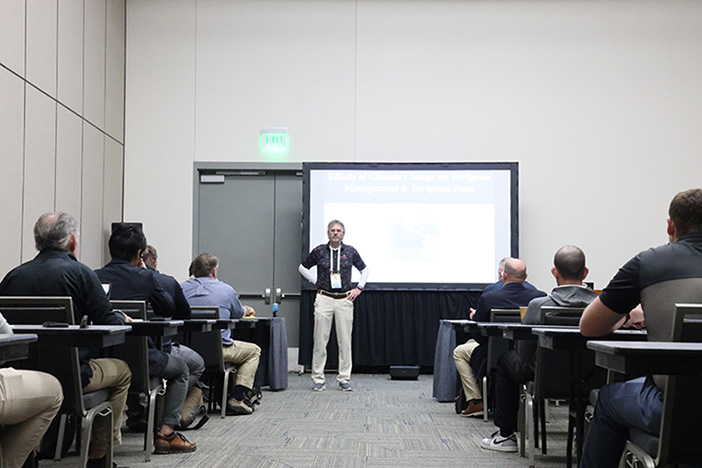
Fred Yelverton, Ph.D., discusses climate-related changes in turfgrass management with superintendents at the 2025 GCSAA Conference and Trade Show in San Diego. Photo by Tyler Stover
Three scientists shared their thoughts regarding climate change Feb. 3 with superintendents gathered for the 2025 GCSAA Conference and Trade Show in San Diego.
Fred Yelverton, Ph.D., Rick Brandenburg, Ph.D., and James Kerns, Ph.D., all faculty members at North Carolina State University, outlined the impacts of changes occurring in climate on weeds, insects and pathogens.
When thinking about climate change, Yelverton encouraged superintendents to first distinguish between weather events and changes in climate. While a historic flood, extreme drought, uncharacteristic cold spell or other isolated event might lead one to attribute such happenings to climate change, a better approach would be to look at patterns and trends over decades or longer periods of time.
“Make sure you understand the difference between weather and climate,” Yelverton said. “Obviously the two are connected, but weather is what you pull up on your phone. Climate is a 30-year trend.”
He used the recent record-setting cold weather that hit the Southeast U.S. in January as an example of extreme weather but not an indication of climate change, which instead would be indicated by a gradual but steady increase in average temperatures or a significant change in rainfall patterns over the course of decades or even longer periods of time. He said evidence that change is occurring is not hard to find but controversy comes when people try to determine what is causing the change.
A pitfall to avoid comes in trying to understand the causes by first forming an opinion and then seeking information that supports your opinion. The scientists urged superintendents to instead try to learn as much about the topic first, then form an opinion.
Yelverton outlined characteristics of the most impactful greenhouse gases, particularly carbon dioxide and nitrous oxide, both of which are important in turfgrass science. He noted the impact rising temperatures are having on turfgrass management, especially those superintendents in parts of the world where many have transitioned from cool-season grasses to warm-season grasses. One big challenge to turfgrass is that nighttime average temperatures are warming more quickly than daytime highs.
“That has a huge effect, particularly on cool-season grasses,” he said. “You’ve got to have the cooler temperatures to get recovery.” Further stressing cool-season grasses is the impact from more days above 90 degrees, and the stress-related increase in pressure from diseases.
Yelverton noted that as golf courses are challenged with the change from cool-season grasses to warm-season grasses, they also are dealing with a change in weeds that formerly only thrived in warmer areas of the U.S. and elsewhere. Troublesome weeds are moving north, bringing new impacts for golf courses.
The complexity of climate change is further impacting golf courses as insects, too, are reacting to warmer temperatures. Brandenburg outlined effects of temperature change on insect development, migration, digestion, survival, reproduction, behavior, flight and metabolism. He noted that studies have shown that plant defenses to insects decrease as CO2 levels increase, and for every 1 degree (Celsius) rise in winter temperature, there is a winter insect mortality decrease of 16.5 percent.
Brandenburg sketched out hypothetical case studies for fall armyworms, white grubs and fire ants, and noted that hunting billbugs are a new pest of warm-season turfgrass, particularly bermudagrass and zoysiagrass.
Kerns described how plant pathogens can be indicators of climate change. One way, he said, was that if the climate changes to favor pathogen reproduction and infection, previous constraints on pathogens will be lessened. In addition, more global movement of people and materials can lead to hybridization of pathogens and the creation of new pathogens.
As examples, he noted that fungicide usage has increased in most agricultural systems, including turf. The lodgepole pine decline is increasing in North America and increases in nighttime temperatures are strongly linked with increases in dothistroma needle blight.
The scientists stressed that superintendents must become as informed as possible about climate change.
“We’re not advocates, we’re educators,” Brandenburg said. “I’m not telling you that you better change what you’re doing, I’m just going to give you information that as you deal with whatever is going on in your location, you can be better at it. That’s really my job.”
Darrell J. Pehr is GCM's science editor.